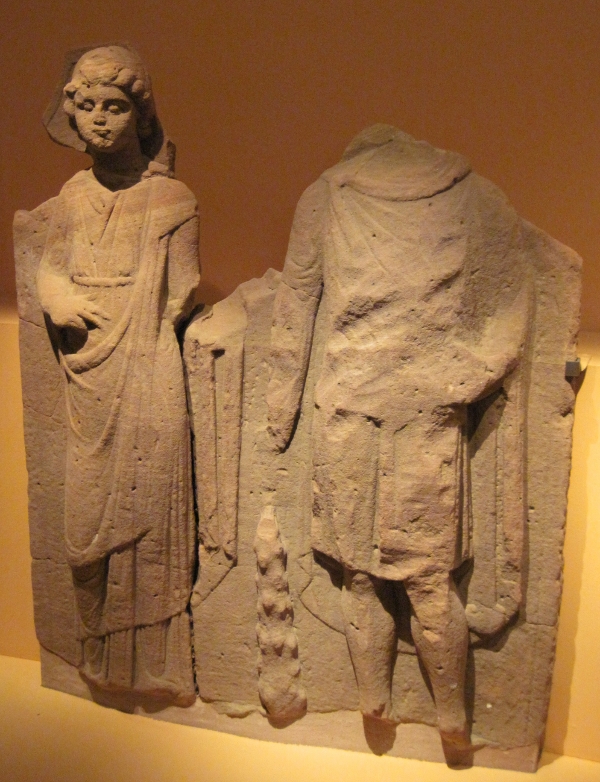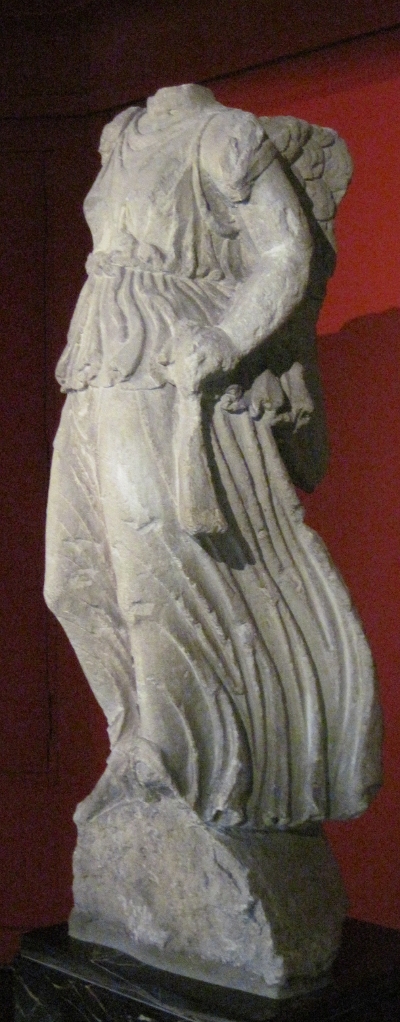DEAE ANCAMNAE: to the Goddess ANCAMNA
Ancamna · Bellona · Boudina · Brigantia · Cathubodua · Litavis · Nemetona · Vagdavercustis · Victoria
The primary focus of this page is Ancamna, a goddess found in the Treveran region, but it also aims to cover other Gaulish goddesses connected to war and/or to the Gaulish Mars. For Mars, like Mercury or Apollo, often appears beside a goddess (whether interpreted as Roman or not). In Mercury’s case, this for the most part means Rosmerta (if not Maia). But the Mars reveals himself in more varied guises, fulfilling more roles and known by a greater number of names. His consorts are also correspondingly more varied. They can appear at Mars’ side on inscriptions as well as in sculpture. In sculpture, unfortunately, the goddess is not always identified; in inscriptions, she may be named without distinctive traits, with the result that we know nothing of her but her name. Where we have both an inscription and a depiction, we can fill in some of these gaps; etymology can also provide some further hints.
Knowing which of Mars’ consorts we’re dealing with on a religious monument can tell us something about Mars, as well as the goddess in question. For example, the companion of Lenus Mers (often a god of healing) can be called either Ancamna or Victoria. By contrast, we find the more warlike Mars Cicolluis in the company of either Litavis or Bellona; Mars Cicolluis never accompanies Ancamna or Victoria. As Lenus Mars plays a healing role, and serves as guardian of the country and tribe, Victoria perfectly complements these functions. Meanwhile, Mars Cicolluis is the ‘muscled’ god who delights in the macho act of fighting, much like Bellona, goddess of combat. If we find an inscription ‘to Mars and Ancamna’, we can therefore have a good idea of which Mars we’re talking about.

(Unfinished) bas-relief of Ancamna and Mars Smertrius, found at Freckenfeld (3rd century). Remarkably, Mars Smertrius (identified as such on the inscription) is depicted here with Hercules’ club as well as with the sword of Mars.
(Historisches Museum der Pfalz, Speyer)
Ancamna
We know less than we might wish about the character and mythology of Ancamna. Her cult image, found at a uilla rustica near Freckenfeld in the territory of the Nemetes, shows her with almost childlike features. She even seems to be pouting. Modestly dressed and with no special attribute in her hand, this unfinished figure is said to resemble Diana by the Historical Museum of the Palatinate.
The inscriptions that associate Ancamna with Mars (with no epithet) do so at Trier, on the slopes of a hill leading up to the great sanctuary of Lenus Mars. One of them also honours one of the genii of the pagi, or districts, that made up the Treveran territory.H. Finke (1927), Neue Inschriften. Berichte der Römisch-Germanischen Kommission, 17, inscription 13. Another inscription, left at a sanctuary at Ripsdorf (in the area of Euskirchen in the Eifel), invokes Lenus Mars and Ancamna specifically for the well-being of the Empire and the divine house (that is, the imperial family), according to its reconstructed text.Finke (op. cit.), inscription 254. These appear as to form a powerful couple, practically the Treveran analogues of Jupiter and Juno—an impression confirmed by the formula in h(onorem) d(omus) d(iuinae) (in honour of the divine house) on many of these stones.
One man who dedicated an ex voto to Lenus Mars and Ancamna at Trier gives himself the interesting title of deuas (his full name is Optativs Vervs Devas), which we also find with a worshipper of Mars Loucetius at Worms.Edith Mary Wightman (1970), Roman Trier and the Treveri. Rupert Hart-Davis, p. 214. This word seems to be linked to the Celtic word dēvos ‘god’—might it be a derivative with the sense of ‘godly’ or ‘devotee of the god’?
We have already mentioned the sanctuary of Mars at Ripsdorf. Another sanctuary at Möhn (near Welschbillig north of Trier) included a small theatre and two temples; Mars Smertrius and Ancamna were worshipped there, perhaps along with other deities as well.Wightman (op. cit.), p. 223.
Victoria

The magnificent monumental statue of Victoria found at Metz. It would have been set up at the beginning of the 1st century as part of a funerary monument.
(Musées de la Cour d’Or, Metz)
Victoria is, shall we say, a natural companion for Mars. The latter’s role is to protect and, if necessary, to fight. Victoria—winged, and more beautiful and transcendent than any angel—bestows the palm of victory to the winning side, thus crowning the conflict while deciding its resolution. Many inscriptions honour Mars and Victory together. At Rome, however, most of these were left by the Equites Singulares Augusti or Emperor’s Own Horse Guard, a cavalry unit with a strong Gaulish component. I find no other such inscriptions elsewhere in Italy. The joint cult of Mars and Victoria is typical of military zones (such as the Germanic limes, the Danube, Britain and Numidia), where, on the other hand, many Celtic contingents were stationed. Such a natural idea as to link this god and goddess belongs to the provinces, and above all to the provinces with Celtic roots.To be sure, there are occasions when the Roman tradition invokes Mars and Victoria together. On important occasions in the life of an emperor, the Arval Brethren at Rome would perform sacrifices to the Capitoline Triad (Jupiter, Juno and Minerva), Mars, Salus and Victoria. Sulla dedicated his trophies to Mars, Victoria and Venus. At Dura-Europos, military regulations prescribed sacrifices on 3 January to Jupiter Optimus Maximus, Juno, Minerva, Jupiter Victor, Mars Victor, and Victoria. In none of these cases do Mars and Victoria form a distinct couple.
In Greek mythology, Victoria—which is to say Nike—is ordinarily a daughter of Styx; she belonged, according to the Greeks, to an early generation of esesntially allegorical deities. The Romans observed a feast of supplication to Victoria Augusta on 15 April; further sacrifices were offered to her on 1 August to commemorate the Battle of Alexandria and on 28 August at the Altar of Victory in the Curia Julia.Corpus Inscriptionum Latinarum (CIL) X: 3682 (inscription at Cumæ); Inscriptiones Italiæ 13-02, 17 (inscription at Præneste); CIL VI: 2297 (inscription at Rome). After the Empire fell to the Galilean superstition, the Christian emperors were bitterly reproached for neglecting this simple worship of Victoria in the Senate in the midst of so many calamitous defeats.This is the subject of a speech by Symmachus, the Relatio III (English translation), in the year 384.
At times Victoria covers the same terrain as other goddesses who are also known by Gaulish names. I have mentioned the usual connection between Lenus Mars and Ancamna, but there are also inscriptions honouring Lenus Mars and Victoria, Mars and Ancamna, and Mars and Victoria. The same goes for Mars Loucetius and Nemetona: one inscription at Eisenberg even invokes Victoria Nemetona, uniting the two goddesses under a single appellation. (Nemetona’s name is thought to mean ‘of the sacred grove’, or, in a wider sense, ‘of the sanctuary’.Xavier Delamarre (2003), Dictionnaire de la langue gauloise. Errance, pp. 232-233.) This is evidently an interpretatio gallica—an identification of a Gaulish goddess with her Roman equivalent, made by the Gauls themselves. Such an identification implies a new mythography that gave particular importance to Victoria while also emphasizing her relationship with Mars. It has been remarked that Mars Loucetius and Nemetona “are closely similar to if not identical with, Lenus and Ancamna”.Wightman (op. cit.), p. 219. The former couple’s domain appears to be the area of Mainz, while that of the latter was that around Trier, but in either case their function seems similar.
We should also note that Victoria was identified with Brigantia in Great Britain. This goddess was the patron of the tribe of Brigantes, who inhabited what is now the north of England; it is thought that she was promoted by the 3rd-century Severan dynasty to give a religious focus for local loyalty to the newly reorganized Brigantian state within the Roman Empire.N. Jolliffe (1941), “Dea Brigantia”, The Archaeological Journal XCVIII, pp. 36–61, cited in M. A. Marwood (April/June 1984), “A Reappraisal of the Altar of Iulius Apolinaris at Corbridge, Northumberland”, Latomus 43: 2. Etymologically, the name Brigantia is related to that of Brigit of Ireland. Among the relatively few deities invoked by name in Gaulish-language texts, we find Brigindu (with an -n- stem) or Brigindona. The text in question comes from a stone slab found at Auxey-Duresses in Burgundy’s Côte-d’Or:
ICCAVOS OP/PIANICNOS IEV/RV BRIGINDONI / CANTALON
Iccavos son of Oppianos dedicated to Brigindu this cantalon.CIL XIII: 2638. See also the description page at L’Arbre Celtique (in French).
What a cantalon is has been debated; in any case, here we have another goddess whose name also derives from the same root brigant-, meaning ‘height’ (in all senses).
Even if these two Victorias—Brigantia and Nemetona—are entirely distinct, it is clear that the Gaulish Victoria goes well beyond allegory.
Bellona
Victoria represents the happy outcome of conflicts; she is thus naturally associated with peace. The role and character of Bellona are quite different. The latter, riding in her chariot, watches over the very act of fighting. She wears a helmet, or else bares her head from which snakes grow instead of hair. Unlike Victoria/Nike, Bellona/Enyo can be considered in Greek mythology to be Mars/Ares’ wife, or else his sister. A goddess identified with Victoria should thus have a distinctly different character from one identified with Bellona.
Such is the case with Mars Cicolluis and Litavis. There is reason to think that Cicolluis designates the god’s warlike aspect (and let us not forget that Mars can also be a healer, a protector the tribal territory, a guarantor of public institutions, etc.). Favoured among the Lingones and their neighbours, Mars Cicolluis is invoked either with Litavis or with Bellona. (Inscriptions dedicated to Mars and Bellona are, by contrast, nearly unknown outside of Gaul.) Nonetheless, the name Litavis has been interpreted to mean ‘the Earth’; the word appears to be a perfect cognate of the Sanskrit Prithvī (the name of a Vedic earth- and mother-goddess), and also related to an ancient name of Brittany (Letha in Old Irish, Letau in Old Breton, and Llydaw in Welsh even to this day).Delamarre (op. cit.), pp. 203-204.
Other warrior goddesses
Another class of warrior goddesses warrants mention here—those whose names indicate a warlike function evn though they are not directly linked with Mars. One of these is called Cathubodua (‘battle-crow’); she is known from an inscription from the country of the Allobroges in today’s Savoy.CIL XII: 2571. The existence of a Badb Catha in Irish mythology—a sinister spirit who appears on the eve of battle in the form of a raven—makes it easier to interpret this goddess’s role.It has become the custom to exaggerate the significance of whichever deities in Gaul seem to have Irish or Welsh equivalents. However, a wide gulf separates ancient Gaul from mediæval Ireland, and only one or two inscriptions mention Cathubodua. Badb Catha is a hypostasis of the Morrígan, ‘Great Queen’ of Irish mythology and one of that island’s principal deities.
The root bodua ‘crow’ should not be confused with boudi- ‘victory’, despite their shared martial connotations. It is the latter root that we find in Boudina, the name of a deity known only from the Treveran country. Our inscriptions mention other deities alongside Boudina, namely (1) Alauna at Pantenburg in the area of Bernkastel-Wittlich, Rhineland-Palatinate (on both altars) as well as Deus Voroi(us) (only on one; this god, invoked as Vorioni deo at Trier, “may [...] have been connected with water and fords” according to Edith Wightman); Wightman (op. cit.), p. 218. The inscription invoking [BO]VDINAE / [E]T ALAVNAE is Finke (op. cit.), inscription 82; that invoking DEO VOROI / BOVDINAE / ET ALAVNAE is Finke, 83. The one invoking Vorio in Trier is AE 1941, 170. (2) the honour of the divine house, the numen of Augustus, Mars Smertrius and [...] Vindoridius Boud[..]na at Liesenich in the area of Cochem-Zell in the same state.CIL XIII: 11,975. The site at Pantenburg included a sacred spring and a Jupiter–giant column. At first glance, the inscription at Liesenich seems to make Boudina a consort of Mars Smertrius and therefore an analogue of Ancamna. But if the reading is correct, and Vindoridius is male, Boud[..]na appears to be a masculine name of the first declension that was applied to Vindoridius. In Latin there are many masculine proper nouns ending in -aCompare, by way of example, Agricola, Agrippa, Cæcina, Catilina, Cinna, Cotta, Dolabella, Galba, Geta, Messalla, Murena, Nerva, Publicola, Scævola, Seneca, Sulla, etc. Latin also has druida and Celta, which are masculine nouns of Celtic origin. By contrast, feminine nouns of the second declension are more rare; it is thus more likely that Vindoridius Boudina is masculine than feminine.—and no inscription specifies that we are talking about a goddess Boudina. This companion of Mars Smertrius would thus appear to be male. The name Alauna (almost certainly feminine, because the masculine form Alaunus is also attested) might mean ‘nourishing’ or else ‘wanderer, nomad’; it is often given to rivers.Delamarre (op. cit.), p. 37. Might Alauna then be the tutelary goddess of a local waterway? (In this case, it would probably not be the Lieser, which is called the Lesura at least at the time of Ausonius.) In any case, while Alauna and Deus Voroius are linked to Boudina, they are not as far as I know directly linked with Mars.
The names of a few other deities also seem to contain the root boudi-: at Bordeaux we have the ‘goddess Tutela Boudig(a)’ honoured on an altar that includes depictions of mother goddesses, a river god, and a crude animal (a boar?);AE 1922, 116; see also images of these depictions. at Cologne, two inscriptions invoke the ‘Matronae Boudunne(ih)ae’,CIL XIII: 8217; AE 1969/70, 440. who may however have more to do with Germanic than Celtic religion.
Also in Germania Inferior is a goddess (of war?) called Vagdavercustis. Her altar at Cologne is decorated with trees, just like another altar dedicated at Mainz to Bellona.CIL XIII: 6 666. Might a devotee of Vagdavercustis, knowing that her name was unknown there, have chosen to inscribe that of Bellona instead? Like those dedicated to Vagdavercustis, the altar of Bellona at Mainz makes no mention of Mars.
Nemesis is fairly clearly invoked at Dalheim and Öhringen. We may note that this avenging goddess had a better reputation in Antiquity than she has today. In punishing the wicked, she was linked with the re-establishment of good order, and thus with keeping the peace. The motif of Pax-Nemesis thus appears on the coins of Claudius (who incidentally was a Roman born in Gaul). Nemesis was also sometimes linked with Diana; there is one altar dedicated to Diana Nemesis at Cologne and another to Nemesis Deana (sic) at Bonn, while an ambiguous abbreviation at Grand may also link the two goddesses.The inscriptions in question are, at Dalheim, CIL XIII: 4052; at Öhringen, CIL XIII: 6542; at Cologne, AE 1962, 107; at Bonn, AE 1953, 93; and at Grand, CIL XIII: 5936. A limestone statue at Carnuntum in present-day Austria depicts a goddess of this hybrid type: dressed as an Amazon, she holds a scourge and a sword of Justice; on her head is the crescent moon of Diana; at her side are the griffin and wheel of Nemesis.Michael B. Hornum (1973), Nemesis, the Roman state and the games. Brill, p. 66.
Conclusions
Just as Mars might be Gaul’s most multiform god, his female companions are diverse. There are goddesses who are identified with the Roman Victoria, such as Ancamna and Nemetona among the Treveri and their neighbours. Other goddesses are more closely associated with bloody combat; this is undoubtedly the case with Litavis, whom the ancients sometimes interpreted as Bellona, and probably with Cathubodua as the presumed counterpart of Badb Catha.
These goddesses achieve the work of Mars, whether by guaranteeing the community’s well-being or by attacking its enemies. Other goddesses such as Vagdavercustis have to do with war without apparently being linked with Mars.
Although modern writers sometimes assimilate the Irish Brigit with the Gaulish Minerva, or more specifically with Belisama, Brigit’s British counterpart Brigantia is identified instead with Victoria. It might therefore be more fruitful to compare Brigit and Brigantia not with Belisama but with other deities identified with Victoria, particularly the Gaulish Nemetona and Ancamna.
Notes and references

En français svp !

Auf deutsch, bitte!
